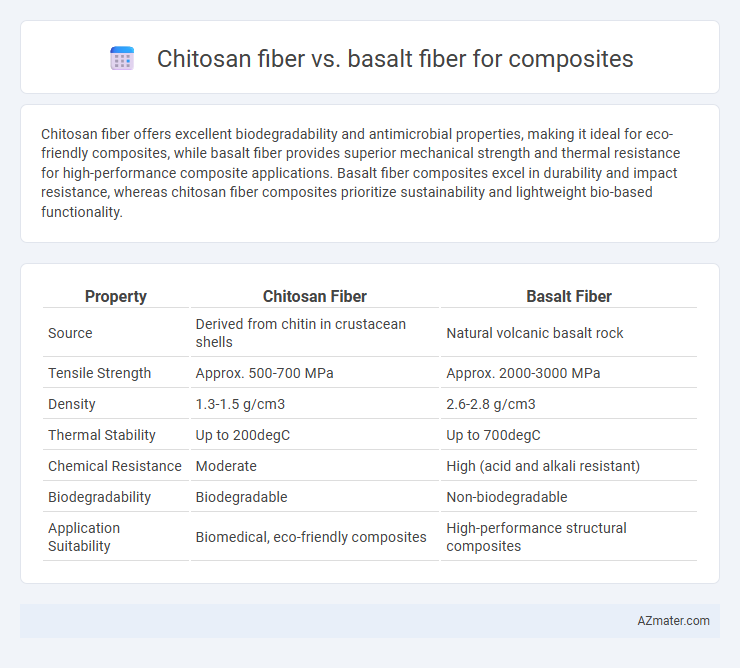Chitosan fiber offers excellent biodegradability and antimicrobial properties, making it ideal for eco-friendly composites, while basalt fiber provides superior mechanical strength and thermal resistance for high-performance composite applications. Basalt fiber composites excel in durability and impact resistance, whereas chitosan fiber composites prioritize sustainability and lightweight bio-based functionality.
Table of Comparison
| Property | Chitosan Fiber | Basalt Fiber |
|---|---|---|
| Source | Derived from chitin in crustacean shells | Natural volcanic basalt rock |
| Tensile Strength | Approx. 500-700 MPa | Approx. 2000-3000 MPa |
| Density | 1.3-1.5 g/cm3 | 2.6-2.8 g/cm3 |
| Thermal Stability | Up to 200degC | Up to 700degC |
| Chemical Resistance | Moderate | High (acid and alkali resistant) |
| Biodegradability | Biodegradable | Non-biodegradable |
| Application Suitability | Biomedical, eco-friendly composites | High-performance structural composites |
Introduction to Chitosan Fiber and Basalt Fiber
Chitosan fiber, derived from chitin found in crustacean shells, offers exceptional biocompatibility, biodegradability, and antimicrobial properties, making it ideal for eco-friendly composite applications. Basalt fiber, produced from volcanic basalt rock through a melting process, boasts superior mechanical strength, thermal stability, and chemical resistance, suitable for high-performance composite materials. Both fibers present sustainable alternatives in composite technology, with chitosan emphasizing environmental benefits and basalt emphasizing durability and strength.
Material Origins and Production Processes
Chitosan fiber originates from the deacetylation of chitin found in crustacean shells, involving chemical treatment to extract and regenerate it into fibers, emphasizing biodegradability and renewable resources. Basalt fiber is produced by melting natural basalt rock at around 1,400degC, then extruding it into continuous filaments, highlighting its volcanic mineral origin and energy-intensive manufacturing. The contrasting raw materials and production methods influence their respective environmental impacts, mechanical properties, and suitability in composite applications.
Mechanical Properties: Strength and Elasticity
Chitosan fiber exhibits moderate tensile strength and excellent elasticity due to its biopolymeric nature, making it suitable for flexible composite applications requiring biodegradability. Basalt fiber offers superior mechanical strength with tensile strengths ranging from 2,800 to 4,800 MPa and higher Young's modulus, providing exceptional stiffness and durability in composite materials. The choice between chitosan and basalt fibers depends on the application's need for mechanical robustness versus biodegradability and flexibility in composite structures.
Thermal Stability and Fire Resistance
Chitosan fiber exhibits moderate thermal stability with degradation occurring around 250-300degC, making it suitable for composites requiring biodegradable materials but limited high-temperature applications. Basalt fiber, derived from volcanic rock, offers excellent thermal stability withstanding temperatures up to 700degC, providing superior fire resistance and maintaining structural integrity in extreme heat. Consequently, basalt fiber composites outperform chitosan fiber composites in high-temperature environments and fire-resistant applications.
Environmental Sustainability and Biodegradability
Chitosan fiber, derived from crustacean shells, offers superior environmental sustainability and biodegradability compared to basalt fiber, which is an inorganic volcanic rock material with limited decomposition capability. The biodegradable nature of chitosan fiber reduces long-term waste accumulation in composite applications, promoting eco-friendly disposal and minimizing ecological impact. Basalt fiber composites, while strong and durable, pose challenges in recycling and environmental degradation due to their non-biodegradable mineral composition.
Composite Fabrication Techniques
Chitosan fiber and basalt fiber differ significantly in composite fabrication techniques due to their distinct material properties. Chitosan fibers, derived from biopolymers, are often processed using wet spinning or electrospinning methods tailored for biodegradable composites, enabling controlled porosity and biocompatibility. Basalt fibers, produced through melting and extrusion of basalt rock, integrate effectively into composites via traditional techniques like resin transfer molding (RTM) and filament winding, offering superior thermal stability and mechanical strength for structural applications.
Performance in Structural Applications
Chitosan fiber exhibits excellent biodegradability and antimicrobial properties, making it suitable for eco-friendly composite materials with moderate mechanical strength. Basalt fiber outperforms chitosan in tensile strength, thermal stability, and resistance to chemical corrosion, making it ideal for high-performance structural applications requiring durability and long-term integrity. The choice between chitosan and basalt fibers depends on balancing environmental impact and mechanical performance constraints in composite design.
Cost Analysis and Market Availability
Chitosan fiber offers a biodegradable and renewable option in composite materials but incurs higher production costs due to complex extraction and processing methods, limiting its widespread market availability. Basalt fiber provides a cost-effective alternative with strong mechanical properties and abundant natural raw material sources, resulting in greater market penetration and industrial adoption. The economic advantage and accessibility of basalt fiber make it a preferred choice for large-scale composite manufacturing compared to the niche and emerging status of chitosan fiber.
Limitations and Challenges
Chitosan fiber faces limitations in composite applications due to its lower mechanical strength and moisture sensitivity, which can compromise durability and performance under harsh environmental conditions. Basalt fiber offers superior thermal stability and mechanical properties but challenges include higher production costs and difficulties in achieving optimal fiber-matrix adhesion. Both fibers require advanced surface treatments and compatibility improvements to enhance their integration and long-term reliability in composite materials.
Future Prospects and Research Directions
Chitosan fiber offers biodegradable and antimicrobial properties, making it a promising candidate for sustainable composite materials with applications in biomedical and environmental sectors. Basalt fiber provides superior mechanical strength, thermal stability, and chemical resistance, attracting research focused on enhancing durability and structural performance in automotive and aerospace composites. Future research directions emphasize improving interfacial bonding in chitosan composites and optimizing basalt fiber processing techniques to reduce production costs while expanding multifunctional applications.

Infographic: Chitosan fiber vs Basalt fiber for Composite
 azmater.com
azmater.com